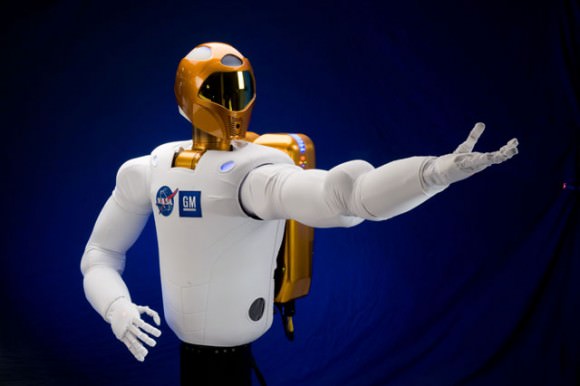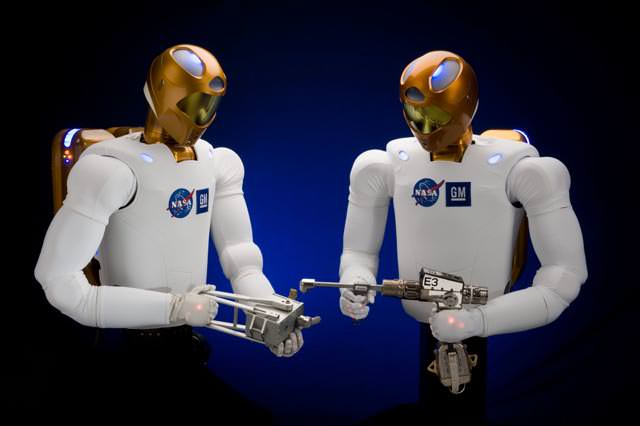[/caption]
Not sure if it speaks Bocce or understands the binary language of moisture evaporators, but the next generation of NASA’s Robonaut is about to move into the workforce in the automotive and aerospace industries. Engineers and scientists from NASA, General Motors and Oceaneering Space Systems of Houston have worked together to build a new humanoid robot capable of working side by side with people. Robonaut 2, or R2, is a faster, more dexterous and more technologically advanced robot than its predecessor, and this next generation robot can use its hands to do work beyond the scope of prior humanoid machines. R2 can work on Earth or in space.
“This cutting-edge robotics technology holds great promise, not only for NASA, but also for the nation,” said Doug Cooke, NASA’s associate administrator for the Exploration Systems Mission Directorate. “I’m very excited about the new opportunities for human and robotic exploration these versatile robots provide across a wide range of applications.”
Using leading edge control, sensor and vision technologies, future robots could assist astronauts during hazardous space missions and help GM build safer cars and plants.

“For GM, this is about safer cars and safer plants,” said Alan Taub, GM’s vice president for global research and development. “When it comes to future vehicles, the advancements in controls, sensors and vision technology can be used to develop advanced vehicle safety systems. The partnership’s vision is to explore advanced robots working together in harmony with people, building better, higher quality vehicles in a safer, more competitive manufacturing environment.”
The original Robonaut, a humanoid robot designed for space travel, was built about 10 years ago at Johnson Space Center. During the past decade, NASA gained significant expertise in building robotic technologies for space applications. Will these new robots go to galaxies far, far away and be grease monkeys? Only time will tell.
Source: NASA


Do they do windows?
Actually, I’d like to get a bunch of em to clean up the bottom of our oceans… That big pile of plastic the size of the state of Texas, which is floating around in the mid Pacific, is just the ‘tip of the iceberg’, in a manner of speaking.
Good for EVA’s
What has the UAW got to say about this?
they don’t look like cylons … yet.
So are those handle remotely controlled by a human? Some sort of glove with feedback? The benefit would be the lack of cumborsome spacesuit gloves, but that puts a technological layer between the user and the object. It’s not exactly like being there.
Next time I look at any of my screwdrivers I will think “hey, can opener!”
Actually, they look a lot less can-like than the clunky R2. In the movies one can see them even do dumbbells with the same load bearing dynamics as humans!
With neural interfaces it’s exactly as being there.
[Slightly kidding. Of course our consciousness is embodied, so it will never be the same just because there’s a direct interface. OTOH the brain is stupendous in its plasticity – with enough sensors and actuators interfaced it will adjust to feel like being there.]
Duh, I forgot proofs for my claims:
“our consciousness is embodied”
Witness our arm and leg movements, which are autonomous robotic routines output by pattern generators situated in brain stem thickenings in respectively places near “the actuators”, consciously overridden when need be. But experienced as “free will” and “planned” processes.
“with enough sensors and actuators interfaced it will adjust to feel like being there.”
Mots of that experiment has already being done, last year IIRC. With some technological trickery you can get people to have “out-of-body” experiences where they feel they are watching themselves from behind. In that case it isn’t plasticity as such but circumventing the need by latching on to the above embodying of our distributed mind. This demonstrates the “feel” part.
The remaining part of the claim is plasticity and is well known. For example by using reversing eye glasses (projecting the visual field upside down into the eyes) people will eventually reverse the image by themselves. Removing the eye glasses will cause another reversal eventually back to normal vision.
Um, “been done”. -must-have-that-coffee-now-
So you put on a Lycra/skin tight suit, covered with motion sensors. Then you adjust your virtual reality headset and walk into the simulated lunar volcanic tube and activate a robot via ‘tele-presence’ and get busy. We have the technology to do that… and what a cool job that would be! Come on Bill Gates, or ? Cough up some cash and lets get on with it!
or so says the unemployed engineer.
Finally, companions for Dextre, waiting alone on the ISS (http://en.wikipedia.org/wiki/Dextre) 🙂
I hope Nasa works with Honda. They have much more experience with robotic technology.
The new concept: send robots to space, until “spooky action at a distance” will be possible.
Let them build all what we need at Mars, then send humans, Obama knows.
To sent robots to space until technology is mature is a virtue. But man, what is it difficult to wait and have patience.
I think I don’t have any virtue, personally, Life is simply too short. A hundred years from now it will all be possible. Shit.
It does make sense when you control it real-time so you must have close proximity. For example ISS.
It does not make sense on the Moon controlled from Earth and Mars. Too long a delay to control it. And better shapes are for the right job. If this robot has a stuck joint then it is crippled completely when it loses its balance. If a Mars rover has a stuck wheel, it can still drive around.
In pure vacuum this robot make sense since there is no dust to cripple the mechanics.
Why not. The American military is already working on combat models for the field of battle instead of using humans so why not use them for passive purposes in space?
Perhaps robotics in space replaces human exploration is the main goal of Obama – especially as the robots are expendable and they don’t need all the frailties they have to take for humans like air, water and food. Cancelling Ares might have been a good idea after all.
Is a robot saluting an American flag on the moon considered too kitch? Perhaps we may soon find out!
Interesting, however these are (telepresence) machines. With some autonomy, (predicating our intentions).
Without real autonomy we need humans (close enough) to operate them. Thats OK, Given that we can fashion (Space Habitats) capable of sustaining us. Such devices will allow for quick response EVAs and short range exploration.
So the plus side is that humans are still needed in space. I doubt that Artificial Intelligence (the kind Sci-Fi imagines) is anywhere in our near future. If ever.
There are some Nasa vids about the Robonaut on You tube and other sites, worth a watch. 🙂
Damian
@Hon. Salacious B. Crumb
“Is a robot saluting an American flag on the moon considered too kitch?”
So you would feel pride if a human looking robot would salute to the flag on the Moon? But why waste the money on the human looking robot and use the most efficient form for that goal instead. It only make sense if the same tools would be used by humans. But if there are no humans near the robot, then why create a drill that can be handled by a human instead of the best design?
And if you look at the Apollo astronauts, the human form is not really efficient for moving on the Moon. A kangaroo design would be better.
This human form robot only makes sense when humans are near it and use the same equipment.
This robot design is perfect for orbital stations like ISS. No wasting of time to repair something and easy to control. The same tools can be used as humans would.
Also on the Moon, such a robot strapped to the rover you could walk around not having to leave the carbine and still can use the same tools the robot has, so no need of duplicate tools.
@Olaf
“Is a robot saluting an American flag on the moon considered too kitch?”
I was being deliberately ironic here!!
The point was it doesn’t matter how the goals are reached as long as they ARE reached!